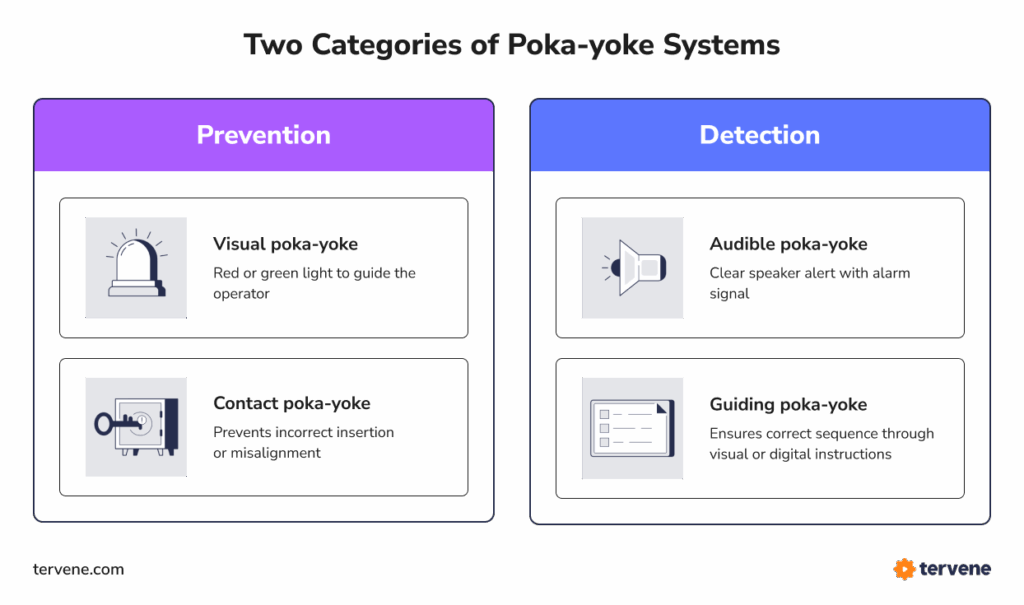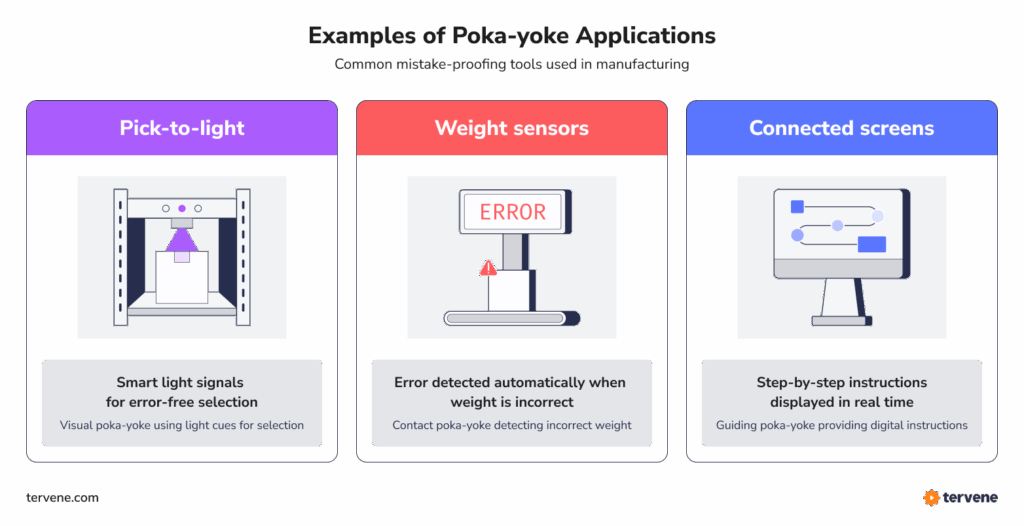Poka Yoke in Manufacturing: Types, Examples & Benefits

| Audience: | Manufacturing Managers, Healthcare Administrators, Operational Excellence and Lean Management Practitioners, HR Coordinators, Organizational Leaders |
| Last updated: | October 10, 2025 |
| Read time: | 9 min |
- Prevent defects before they occur using control and warning systems
- Reduce rework, improve safety, and strengthen standardization
- Combine simple physical devices with digital tools for resilient operations
What Is Poka Yoke in Manufacturing? Lean Definition
Poka yoke in manufacturing refers to any technique or device that prevents or immediately detects an error before it moves downstream. The term, derived from Japanese, literally means “mistake-proofing.”
The Japanese Term for Mistake-Proofing in Manufacturing
The concept was introduced in the 1960s by Shigeo Shingo as part of the Toyota Production System. His goal was to design processes where mistakes are either impossible or immediately visible, instead of relying on end-of-line inspections.
In a well-designed poka yoke system, each step either prevents an error (control method) or detects it early (warning method), allowing teams to take corrective action before waste or defects appear.
Why Poka Yoke Matters in Manufacturing?
Built-In Error and Fail-Proofing for Quality
In modern manufacturing, poka yoke systems are essential to achieving built-in quality, a core Lean principle. By designing operations that make errors impossible or immediately visible, manufacturers can significantly reduce quality costs and improve process flow.
Key benefits include:
- Lower quality costs: Early detection and prevention minimize scrap, rework, and warranty claims.
- Embedded quality: Assurance becomes part of every operation, not just post-production inspection.
- Faster throughput: Fewer stoppages and corrections result in a smoother production flow.
- Simplified training: Mistake-proofing guides operators toward correct actions and supports standard work.
- Improved safety and compliance: Interlocks and sensors ensure that critical steps, such as guard closures or torque checks, are completed before the next phase.
Poorly designed poka yoke systems, however, can frustrate operators. Intrusive devices, trigger false alarms, or slow production may be disabled. Effective mistake-proofing strikes a balance between error prevention, usability, and efficiency.
What Are the Types and Principles of Poka Yoke Systems?
Poka yoke devices are categorized based on how they detect or prevent errors. Each category addresses a different type of process risk.
Control vs. Warning Methods
- Control (Prevention): Physically prevents mistakes, such as through lockout mechanisms.
- Warning (Detection): Alerts operators to potential errors so they can correct them immediately.

Together, these methods make errors either impossible or immediately visible, strengthening process stability.
The Three Types of Poka Yoke Methods
Contact or Attribute Method (Forcing Design Principle)
This method detects physical attributes such as shape, size, color, or presence and triggers a response if a mismatch occurs.
Example: A fixture that only accepts a part in the correct orientation, or a sensor that verifies component presence before continuing.
Fixed-Value Method
This method ensures a fixed number of operations or parts are completed before moving on.
Example: Containers preloaded with the exact number of bolts required for assembly. If any remain, the system signals an incomplete task.
Motion-Step or Sequence Method
This method monitors the order of operations. If a step is skipped or performed out of order, the system intervenes.
Example: A workstation that requires digital confirmation of Step 2 before Step 3 begins.
Industry leaders use Tervene to sustain and track mistake-proofing across operations

Examples of Poka Yoke Mistake Proofing in Manufacturing

Assembly and Fabrication
In assembly and fabrication, poka yoke techniques prevent human error and defective products by designing processes that make mistakes physically impossible. These poka-yoke devices ensure that only correctly made parts continue downstream, improving quality and efficiency across the manufacturing process.
- Orientation fixtures that only allow correct part positioning
- Go/no-go gauges verifying dimensions before parts move downstream
- Color-coded connectors that prevent mismatched assembly
Kitting and Picking
Poka yoke in material handling focuses on eliminating mix-ups before they occur. By designing systems that limit a certain number of movements or guide operators step-by-step, manufacturers can reduce conditions that lead to defects or missing components.
- Pick-to-light systems guide operators to the correct bin
- Prepackaged kits ensure all required parts are present before assembly
Machinery and Safety
Mistake-proofing is essential in machinery and equipment operation, where workers and employees must perform safely and consistently. Devices such as sensors, interlocks, and alarms prevent unsafe conditions, stop equipment before defective products are made, and ensure corrective action happens immediately when an issue arises.
- Interlocks that prevent operation unless doors or guards are securely closed
- Sensors detecting missing or misaligned parts before a cycle starts, triggering a warning for operators
Digital Workflows
As factories digitize, poka yoke principles extend into software and connected tools. Digital devices and platforms standardize processes, prevent skipped steps, and help teams identify the root cause of problems in real time, strengthening both quality and accountability.
- Electronic checklists enforcing task sequences
- Barcode or RFID scans verifying correct part or tool selection
Everyday Examples
Poka yoke concepts are found far beyond the production floor. Everyday objects apply the same logic, designing conditions that make mistakes impossible or immediately visible, offering a relatable way to understand poka-yoke techniques.
Examples:
- USB plugs that fit only one way
- Microwave ovens or washing machines that won’t run with the door open
- Cars that require the brake pedal to be pressed before ignition
In Lean environments, poka yoke supports continuous improvement by building quality into the process rather than inspecting it afterward. The benefits of poka yoke include improved employee safety, reduced defective products, and enhanced customer satisfaction.
When workers and leaders adopt a shared mindset of mistake-proofing, human error becomes an opportunity for learning and lasting improvement.
Track compliance, follow-ups, and poka yoke performance with Tervene’s tools
How to Implement Poka Yoke in Manufacturing? Step-by-Step Implementation Guide
1. Map Your Process and Identify Error Points
Walk the line and analyze the quality of the data. Use Pareto charts, defect logs, and operator feedback to pinpoint where and why errors occur.
2. Choose the Simplest Effective Method
Start small. Many of the best poka yoke devices are simple pins, guides, or color markings. Select the right detection type (contact, fixed-value, or sequence) for each error mode. Avoid overengineering.
3. Pilot and Test
Deploy in a controlled area. Track whether defects decline and gather feedback to ensure the device supports flow and comfort.
4. Iterate and Refine
Adjust sensitivity and ergonomics. Remove nuisance alarms and ensure usability. Involve operators in continuous feedback.
5. Standardize and Scale
Once proven, include the poka yoke in standard work instructions, training, and visual aids. Audit regularly through Layered Process Audits (LPA).
6. Monitor and Improve
Use dashboards to monitor errors and false triggers. Analyze trends to identify new improvement opportunities.
7. Embed Cultural Adoption
Encourage operator ownership through Kaizen workshops or idea programs. Recognize teams that develop practical mistake-proofing solutions.
Pro tip: Document poka yoke devices in your Leader Standard Work and review their effectiveness during tier meetings.

Explore 10 Visual Management Must-Haves [PDF]
Common Pitfalls and Considerations
Even well-intentioned poka yoke designs can fail if not implemented thoughtfully. While the method aims to simplify the manufacturing process, poor execution can create new problems instead of preventing them. Common pitfalls include:
- Overly strict systems that cause frequent stoppages or false alarms
- Poor ergonomics that make tools uncomfortable or awkward to use for employees
- False positives that lead operators to ignore or disable alerts
- Lack of operator and worker involvement in design
- Isolated implementation that shifts defects elsewhere
A poka yoke system only works as long as it’s maintained. Reviewing results, learning from data, and keeping operators involved ensure that the process stays relevant as your operations evolve. Many failures come from not addressing the root problem.
For example, a contact method or motion-step control that doesn’t fully detect variation in shape or size. Regular audits and feedback loops help prevent these oversights and sustain long-term reliability.
Building a Culture of Mistake-Proofing
Poka yoke is a quality tool and a mindset rooted in proactive leadership. When teams consistently apply poka yoke techniques, they reinforce accountability and continuous improvement across all levels of the organization.
Organizations that sustain poka yoke principles typically:
- Review mistake-proofing and examples of poka yoke in regular Tier meetings
- Empower frontline teams to design and refine new poka yoke examples
- Track poka yoke devices within daily management systems
- Celebrate ideas that prevent defects and reduce variation at the source
By making mistake-proofing a shared responsibility, manufacturers build stronger systems that protect both operators and customers. The result is safer workplaces, higher-quality products, and greater customer trust in the final output. Whether it’s in assembly lines or car production, the ongoing benefits of poka yoke come from people who think proactively, identify risks early, and act before issues reach the customer.
Poka Yoke and Digital Manufacturing Integration
Modern factories combine physical mistake-proofing with digital error detection for stronger, more resilient systems. Smart poka yoke devices, such as sensors and cameras, connect with software to provide real-time visibility and ensure consistency across the manufacturing process, helping teams produce higher-quality parts in less time.
Smart Sensors and Vision Systems
These devices detect misalignment, missing components, or contamination before defects occur.
- Connected leader software uses digital checklists to enforce correct sequences
- Analytics dashboards give supervisors insight into recurring issues
- Integrated alerts notify team leaders when deviations occur, enabling faster root-cause action and data-driven improvement
These digital signals create a closed-loop system where every error is visible, measurable, and correctable. For example, in car manufacturing, poka yoke systems might verify torque levels or confirm exact quantities of bolts installed before a vehicle advances. Even a mobile phone uses poka yoke principles by asking for confirmation before deleting files or sending data. This blend of analog and digital poka yoke ensures safety, traceability, and quality from assembly to inspection.
How Tervene Supports Poka Yoke Initiatives
Tervene helps manufacturers implement and sustain poka yoke principles with digital tools that connect leaders and teams while standardizing best practices. In complex production environments, even minor errors can have serious consequences, from quality escapes to safety incidents. Tervene provides the visibility and structure needed to catch mistakes early through built-in inspections and proactive management routines.
With Tervene, leaders can coordinate various activities, including audits, Gemba walks, Tier meetings, and preventive and corrective actions (CAPA), all from one connected platform. Our tools enable teams to respond quickly to changing situations on the shop floor, ensuring that mistake-proofing systems remain effective and continuously improved.
- Digital checklists and audits: Ensure every poka yoke remains functional, verified, and visible through real-time follow-up.
- Leader Standard Work tools: Reinforce proactive supervision, structured source inspection, and consistent error follow-up.
- Dashboards: Centralize issues, feedback, and corrective actions, making it easier to monitor recurring situations or quality risks.
- Tier meeting integrations: Share insights, assign owners, and track poka yoke performance across meetings, shifts, and plants.
Through the combination of human insight and digital structure, Tervene empowers organizations to anticipate errors, reduce serious consequences, and ensure consistent performance across plants and operations.
Standardize and Track Your Poka Yoke Practices
- Perform checks and inspections on mobile or tablet
- Build custom checklists to verify poka yoke systems
- Schedule regular follow-ups and track issues

FAQ: Poka Yoke Manufacturing
Poka yoke is a Japanese term meaning “mistake-proofing.” In manufacturing, it refers to methods and devices that prevent human error or detect it immediately. These solutions ensure defects are corrected before they move downstream, improving safety, quality, and efficiency.
The term poka yoke comes from two Japanese words:
-
poka (ポカ) — meaning “error” or “mistake”
-
yoke (よけ) — derived from the verb yokeru (よける), meaning “to avoid” or “to prevent.”
So, poka yoke literally translates to “error avoidance” or “mistake prevention.”
In practice, poka yoke refers to methods or devices designed to prevent human errors or detect them immediately in manufacturing processes. These systems help ensure that defects are corrected before they move downstream, improving safety, quality, and efficiency.
Common examples include go/no-go gauges, color-coded connectors, sensors that stop machines if parts are misaligned, and digital checklists that prevent skipped steps. Even everyday items such as car ignitions requiring the brake pedal pressed or a mobile phone asking for confirmation before deleting files demonstrate poka yoke in action.
The main types are:
- Contact (Attribute) method: Detects physical differences like shape, size, or color.
- Fixed-Value method: Ensures an exact number of actions or parts are completed before moving on.
- Motion-Step (Sequence) method: Monitors the correct order of operations and stops or alerts if steps are skipped.
Poka yoke supports both Lean and Six Sigma principles by embedding quality at the source instead of relying on end-of-line inspection. It reduces process variation, lowers waste, and helps teams maintain stable and predictable performance.
Key benefits include fewer defects, faster throughput, better safety, improved training, and lower quality costs. Poka yoke also increases customer satisfaction by ensuring products are right the first time.
A control system prevents the error entirely (for example, a machine that won’t start until all guards are closed). A warning system alerts the operator when an error might occur, allowing them to take immediate corrective action.
Digital platforms, like Tervene, extend mistake-proofing beyond the physical process. They help leaders standardize inspections, track corrective actions, and connect several different activities, such as audits, Tier meetings, and Leader Standard Work, ensuring every poka yoke remains active and effective.
Sustainable poka yoke relies on engagement from both operators and leaders. When employees help design and maintain systems, they’re more likely to identify root causes, suggest improvements, and adapt poka yoke solutions to evolving processes.


























